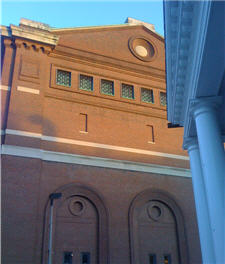 It’s been a few days since I posted anything, but I have good reason. Not only did we push a big release at work at the end of last week, but it’s season opening time at Symphony Hall. This week’s concerts feature two choral masterworks, Stravinsky’s Symphony of Psalms and the Mozart Requiem.
It’s been a few days since I posted anything, but I have good reason. Not only did we push a big release at work at the end of last week, but it’s season opening time at Symphony Hall. This week’s concerts feature two choral masterworks, Stravinsky’s Symphony of Psalms and the Mozart Requiem.
Both works have particular demands on the singer. The Stravinsky is challenging because of the combination of rhythmic precision and intensely fervent power, not only in the loud passages but in the quieter fugues of the second movement. Theologically, Stravinsky’s re-imagining of the Psalms reclaims both the desperation of Psalms 39 and 40 (“Hear my prayer, O LORD, and give ear unto my cry”…”I waited patiently for the LORD”) and the ecstasy of Psalm 150 from their normal status as platitudes. The texts are made over into cantica nova, new songs, and the singer’s challenge is to bring those songs to life against the structural challenges of the work, which include unusual harmonic modes and slow tempi that can either transport the listener or bog the work down into the mire.
When those challenges are surmounted, the work can be amazing, a deft 25 minute masterpiece. I felt good about our Saturday performance but am keeping my wits about me for the final show tomorrow night.
The Mozart Requiem has a different set of challenges. The harmonic language is more familiar, though certainly Mozart’s writing was breaking new ground at the time. But the real challenge is breathing a distinctive life into a work that by turns flirts with overuse (the first movement was used as background music for a mock tragedy on “30 Rock” last season) and obscurity (the little homaged “Hostias” movement). I’ve written about the work before, in my performance on September 11, 2002 and my Tanglewood performance in 2006. This time, the major difference was that I knew the work from memory, mostly, already, and that I knew my vocal instrument well enough to keep from blowing it out in the early movements. (Interestingly, this, the beginning of my fifth season with the chorus, was the first performance that repeated repertoire I had already sung with the choir.)
At the end, the big unifying factor in the two works was the expression of deeply personal faith in two very different times and styles. The Stravinsky grabs new life out of old psalm texts, while the Mozart breathes a very real personal terror of death into the mass for the departed. It’s perhaps no surprise that singing both in the same concert wrings one out like an old washcloth.

3 thoughts on “Double-header: Symphony of Psalms and Mozart Requiem”